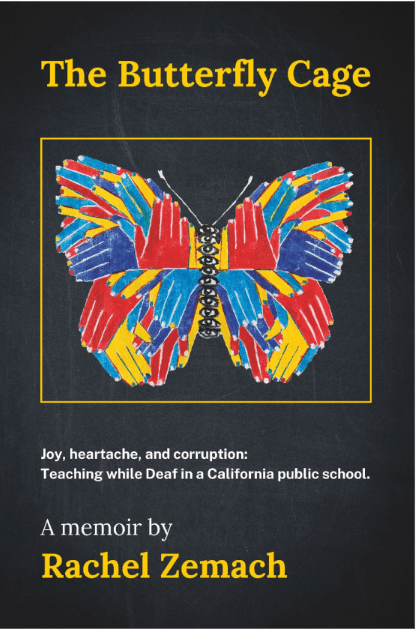Hearing technology, especially cochlear implants (CI), is a multimillion dollar industry: CI’s cost on average $90,000, including follow up services, yet 47% of adults who were implanted as children no longer use them. Many complain of serious problems resulting from them and the Deaf community’s relationship to this “miracle” surgery is complex and contentious. Yet CI surgery is pushed on parents and Deaf adults relentlessly by the medical and related communities. Why, and what is the impact of this that upsets the Deaf community so much?
Rachel Zemach, Deaf educator, writer, and passionate activist on behalf of Deaf and hard of hearing children and adults, is sharing her experience and expertise in her newly released memoir, “THE BUTTERFLY CAGE.” She shares captivating first-hand accounts from her life as a Deaf person and explores the differences in thinking between two major, and often conflicting, viewpoints on how to educate Deaf children, and how she saw the two different approaches impacting students.
“For the medical community, the solution to Deafness as well, is to cure or fix the thing they see as being the problem; ie: the lack of hearing. This is well intended, but they are ignorant of the culture, the community, the pride, and the powerful effect of American sign language (in the US: other countries have different sign languages.) Cochlear implants (CI’s) are a multi million dollar business, and they create many other medical careers as well. Audiology, speech therapy, CI specialists, and so on, are all based around CI surgery. What is less known to doctors is what happens in the actual lives of Deaf people, how often they experience pain/headaches/malfunction from their CI’s, how it stigmatizes them in their beloved community and how many (almost half) of childhood CI recipients stop using them later in life,” says Rachel Zemach, Deaf educator and author.
Talking to the Deaf community, insights extend beyond the clinical and commercial aspects of cochlear implants. They delve deeply into the social and personal ramifications these devices bring. Far from the clinical setting, this story continues to unfold in the everyday lives of Deaf individuals. For many, the experience is far from what they were initially led to expect.
Zemach goes on to say that, “Though well-intentioned, medical professionals are ignorant of the real-life experiences and feelings of Deaf people, and how the CI’s play out over time. They see it as a miracle cure, when in fact it is highly flawed. When their children are implanted, parents are told to wait and see if they learn to speak, and hear. This leads to the biggest problem which is the epidemic levels of language deprivation syndrome that Deaf and hard of hearing children in the US have, due to this period of waiting to see if the CI works; a period which is actually vital for brain development and which often is irreversible in its negative impact. My students, ages 5-11, mostly had no formal language before I met them; some could speak or sign a few words, but they could not answer questions, even simple ones, like if they had a pet, or siblings, or why they were crying, or happy. In my class, they quickly learned ASL, which delivered powerful, full language straight to their brains, and it was like seeing humans wake up, intellectually. Deaf professionals strongly believe all Deaf and hard of hearing children need ASL to avoid language deprivation, early on, whether or not they have hearing devices as well.”
In her book she shares captivating first-hand accounts and explores the differences in thinking between the two major, and often conflicting, viewpoints on how to educate Deaf children. These close-up, poignant stories of charming, individual students and classroom scenes will surprise you as Rachel’s personal encounters intertwine with them as she navigates her own changing Deaf identity. All the while being surrounded by hearing people; both at home and at work. She leads readers through intense educational meetings, bringing out both humor and the dismay they invoke, in her first job. After ten years there, she leaves that position and begins teaching at a large, renowned all-Deaf school. Readers have the unusual experience of accompanying her into that stunningly different world, where attitudes are flipped, linguistic fluency and Deaf culture thrive, and within months, students flourish.
Help keep news FREE for our readers
Supporting your local community newspaper/online news outlet is crucial now more than ever. If you believe in independent journalism, then consider making a valuable contribution by making a one-time or monthly donation. We operate in rural areas where providing unbiased news can be challenging. Read More About Supporting The West Wales Chronicle
























